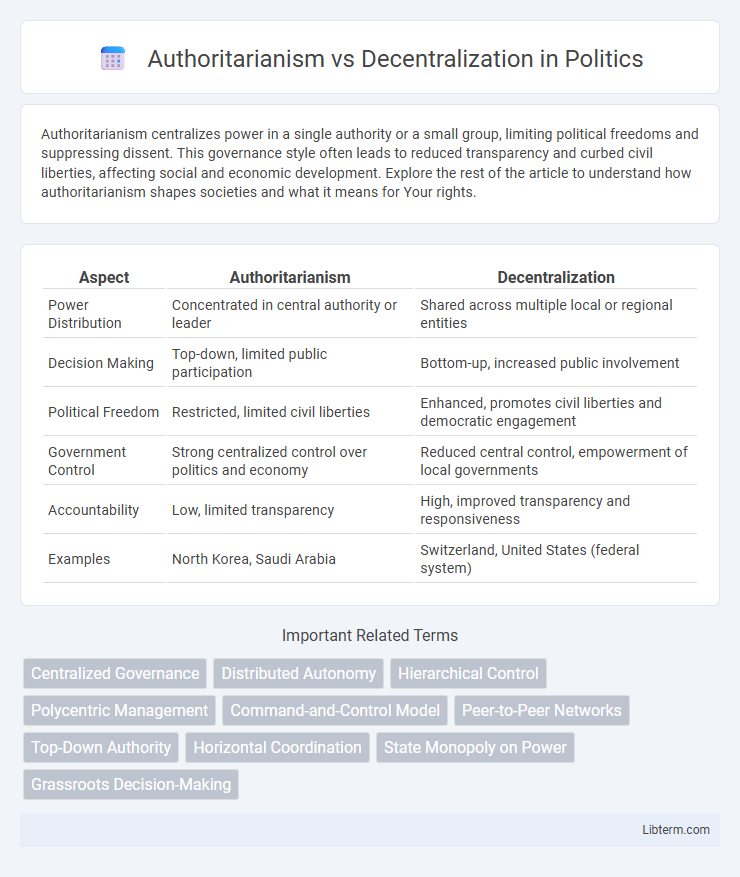Authoritarianism centralizes power in a single authority or a small group, limiting political freedoms and suppressing dissent. This governance style often leads to reduced transparency and curbed civil liberties, affecting social and economic development. Explore the rest of the article to understand how authoritarianism shapes societies and what it means for Your rights.
Table of Comparison
| Aspect | Authoritarianism | Decentralization |
|---|---|---|
| Power Distribution | Concentrated in central authority or leader | Shared across multiple local or regional entities |
| Decision Making | Top-down, limited public participation | Bottom-up, increased public involvement |
| Political Freedom | Restricted, limited civil liberties | Enhanced, promotes civil liberties and democratic engagement |
| Government Control | Strong centralized control over politics and economy | Reduced central control, empowerment of local governments |
| Accountability | Low, limited transparency | High, improved transparency and responsiveness |
| Examples | North Korea, Saudi Arabia | Switzerland, United States (federal system) |
Defining Authoritarianism and Decentralization
Authoritarianism is characterized by centralized power where political authority is concentrated in a single leader or a small elite group, limiting individual freedoms and political pluralism. Decentralization refers to the systematic delegation of decision-making authority from central governments to regional or local entities, enhancing governance responsiveness and public participation. The core distinction lies in control distribution: authoritarian regimes emphasize top-down control, whereas decentralized systems promote dispersed power and localized autonomy.
Historical Origins of Authoritarianism
Authoritarianism traces its historical origins to ancient empires and monarchies where centralized power was concentrated in the hands of a single ruler or a small elite, often justified by divine right or martial dominance. Early examples include the absolute rule of Pharaohs in Egypt and the centralized bureaucracies of Imperial China, which established rigid hierarchies and strict control over social and political life. These systems contrast sharply with decentralization, which emerged in later periods through feudalism and republicanism, promoting dispersed authority and local governance to balance or limit absolute power.
Evolution and Rise of Decentralization
The evolution of decentralization reflects a strategic shift from authoritarian regimes characterized by concentrated power to more distributed governance structures that enhance local autonomy and citizen participation. Advances in technology, increased demand for transparency, and the complexity of modern societies have accelerated the rise of decentralization as a pragmatic response to the inefficiencies of centralized authority. This transformation enables scalable decision-making processes, fosters innovation, and cultivates resilience by empowering diverse stakeholders at multiple levels of governance.
Power Dynamics: Centralized Control vs Distributed Power
Authoritarianism centralizes power in the hands of a single leader or a tight ruling group, concentrating decision-making authority and limiting political pluralism. Decentralization distributes power across various levels of government or organizations, promoting autonomy and empowering local entities to address specific needs. This contrast fundamentally shapes governance styles, with centralized control often leading to uniform policies and rapid decisions, while distributed power encourages diversity, accountability, and participatory governance.
Governance Structures: Hierarchy vs Autonomy
Authoritarianism centers on governance structures with strict hierarchical control, where decision-making authority is concentrated at the top levels and lower tiers follow directives without autonomy. Decentralization promotes distributed governance, granting autonomy to local units or departments, which enhances flexibility and responsiveness. This contrast impacts organizational agility, with authoritarian hierarchies favoring uniformity and control, while decentralized systems support innovation and localized problem-solving.
Economic Impacts: Efficiency and Innovation
Authoritarianism often centralizes economic decision-making, which can streamline processes and reduce transaction costs, leading to short-term efficiency gains. However, this system may stifle innovation due to limited freedom, reduced competition, and suppressed entrepreneurial activity. In contrast, decentralization promotes diversified economic activities and local autonomy, fostering innovation through competitive markets and adaptive resource allocation.
Societal Outcomes: Freedom, Rights, and Security
Authoritarianism often limits personal freedoms and civil rights by centralizing power, resulting in restricted political participation and controlled expression. Decentralization typically enhances societal freedom and protects human rights by distributing authority, promoting transparency, and enabling local governance to address diverse community needs. Security in authoritarian regimes may be maintained through strict control and surveillance, whereas decentralized systems tend to balance security with individual liberties through accountability and citizen engagement.
Case Studies: Global Examples and Lessons
Authoritarianism concentrates decision-making power within a centralized government, often limiting political freedoms and restricting local autonomy, as evidenced in China's tightly controlled governance model. Decentralization disperses authority across regional or local governments, enhancing responsiveness and citizen participation, exemplified by federal structures in Germany and Switzerland. Comparative case studies reveal that while authoritarian regimes can implement swift policies, decentralized systems generally foster innovation and resilience by accommodating diverse local needs.
Technology’s Role in Shaping Governance Models
Technology significantly influences governance models by enabling both authoritarian regimes to enhance surveillance and control through AI-powered monitoring systems and decentralized systems to leverage blockchain for transparent, distributed decision-making. Authoritarian states utilize advanced data analytics and facial recognition to suppress dissent, while decentralized platforms empower citizens by facilitating peer-to-peer interactions and reducing reliance on central authorities. The divergence in technological application underscores how digital tools can either consolidate power or promote participatory governance, shaping the future landscape of political authority.
Future Trends: Balancing Authority and Decentralization
Future trends in governance reveal a dynamic balance between authoritarianism and decentralization, driven by advancements in technology and shifting political landscapes. Emerging models emphasize adaptive frameworks that incorporate centralized oversight with decentralized decision-making to enhance efficiency, transparency, and citizen engagement. Data from global governance indices suggest a growing preference for hybrid systems that leverage AI and blockchain to optimize authority distribution and accountability.
Authoritarianism Infographic

 libterm.com
libterm.com